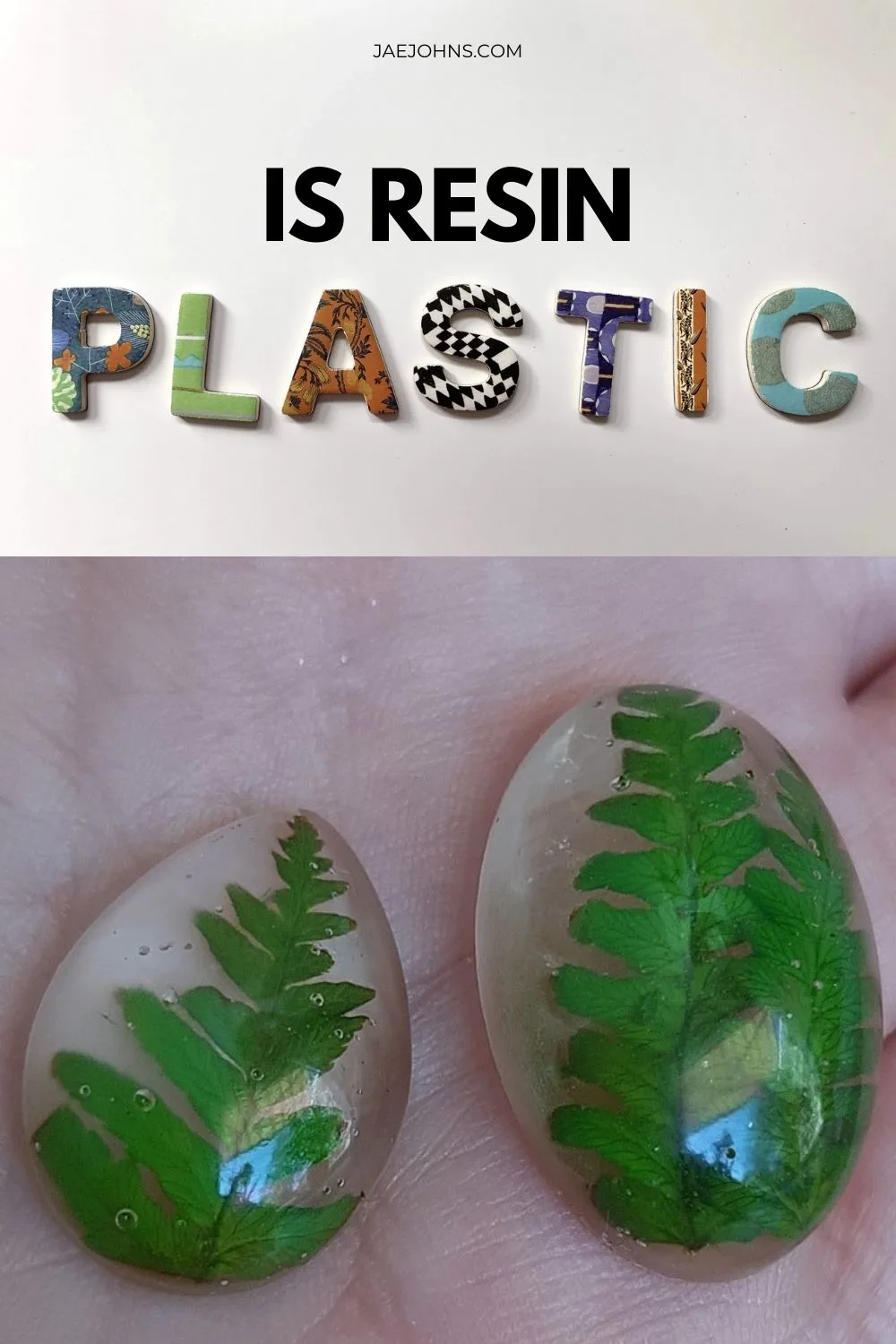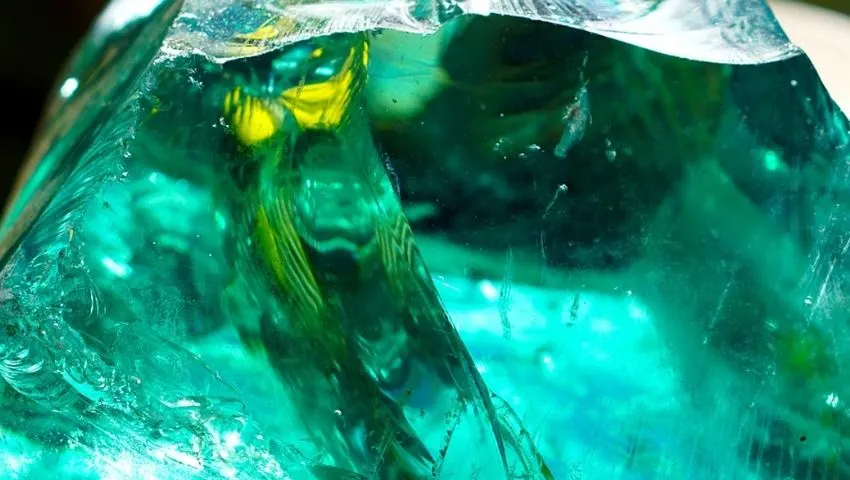You must have come across online businesses selling handcrafted products made of hard resin.
These include earrings, necklaces, decoration pieces, and other trinkets that look tough, durable, and shiny as if they’ve been carved out of plastic. So, is resin plastic?
Resin on its own isn’t plastic. It is actually an organic compound that is naturally found as a liquid. It can’t be used to shape or build anything on its own.
Also, it comes with a liquid hardener and when these two are mixed, they form a strong plastic material.
If you’re someone who wants to learn more about resin and how it can be used to create durable plastic pieces, this is the article for you.
Keep reading to find out how resin artworks, what kind of pieces can be created from it, and what the end product looks like.

What is Resin Plastic Made of?
Let’s talk about what components make up resin plastic.
The modern-day resin that’s used today has been modified over the years to achieve a perfect finish.
In the earlier days, though, resin came from trees.
Tree resin was used as a sort of glue paste that was first heated and then cooled until it was set.
Since I don’t use that kind of resin anymore, let’s talk about what resin plastic is made of today.
The resin we use nowadays contains a material called epoxy.
Epoxy is made up of polymers that are sensitive to temperature.
In technical terms, these are called thermosetting polymers, meaning they harden and set according to the temperature they are cured in.
Epoxy resins are also of two types: non-glycidyl and glycidyl.
I don’t need to explore the differences between them just now.
The main difference is the ratio of resin to hardener that is needed to cure these and make them into resin plastic.
Curing, or drying, can take some time, but there are ways to make your resin dry fast.
How Strong is Resin Plastic?
To answer this question, let’s talk a little bit about Kevlar, one of the world’s strongest materials.
A rope made of Kevlar can apparently be used to pull along a Boeing 737, one of the world’s heaviest planes.
Why is this relevant to a discussion about resin?
Kevlar is in fact a synthetic resin and is deemed to be the strongest artificially manufactured polymer in the world.
It’s also used to pad bullet-proof helmets, jackets, cars, and more. The average person would be unable to tear or break it in any way.
Therefore, I can assume that resins and resin plastics are extremely strong and durable.
Even jewelry made from the material is resistant and tough to break.
The material is also used to help with construction, building, and industrial use, so you can imagine it’s pretty durable.
However, as with any material, it does have its weaknesses and could be broken if enough force was applied to it.
Is Resin Plastic Recyclable?
Unfortunately for environmentalists, resin plastic is non-recyclable.
Containers or products made from this material cannot be considered biodegradable, which means that a company producing them will not achieve green status.
However, a lot of packaging and Tupperware that is made from resin plastic advertises itself to be biodegradable.
This is an advertising gimmick and the companies advertising such may be taken to court as mixed resins are simply impossible to recycle.
Is Resin Plastic Safe and Non-Toxic?
Resin is made up of a lot of chemical components so it’s natural to wonder whether these might harm your health in some way.
Given that synthetic polymers require a lot of expensive ingredients to make non-toxic, should you trust that the resin in your hands hasn’t been through a cost-cutting process? Is resin plastic truly safe and non-toxic?
Yes and no. Craft-grade resin is supposed to be both safe and non-toxic for use.
If you do come into contact with it while it’s mixed with hardener, though, you might experience some unpleasant side effects.
You should quickly wash your hands and seek medical attention if necessary.
Some people also hate the smell of resin as it cures.
Overall, though, it’s supposed to be safe to use and create with.
On the other hand, the same cannot be said for industrial-grade resin.
This is because it takes a lot of expensive ingredients to create non-toxic batches of resin and sometimes manufacturers cut corners.
This results in large vats of poorly made resin that release toxic fumes and chemicals, negatively impacting people and the environment.
There are resin alternatives that are safe and nontoxic.
Is Epoxy Resin Plastic?
Yes, epoxy resin is a type of plastic.
You might not know to look at it, but that’s because there are many different kinds of plastics.
There are main two forms: thermoplastics and thermosets.
The first one is the kind you would find around your house, i.e., the stuff that Tupperware boxes and soap dishes are made of.
Resin melts and this kind of plastic can be melted down into liquid if enough heat is applied.
On the other hand, thermosets can be described as chemical reactions.
These materials cannot be broken or heated and cooled again, making them extremely stable regardless of the conditions around them.
Epoxy resins are thermoset polymers or plastics.
This means that once they are set, they are super durable and can be used to create complex structures.
This sort of plastic is used to coat wires, create weather-resistant paints, and have a lot of other industrial uses that require durable plastics.
Is Polyresin a Plastic?
Polyresin is a derivative of resin compound that is used to create sturdy furniture pieces and statement pieces.
Its selling point is that it can be molded to form almost anything, making it attractive to artists and sculptors. But is polyresin plastic?
Polyresin can be categorized as plastic once it’s finished since plastics make up a lot of different kinds of compounds.
Items made of polyresin are plastic in nature and may be trusted to survive a lot of temperatures and varying environmental conditions.
However, this kind of resin can be a little fragile if it doesn’t have internal supports like wires or mesh.
Is Stone Resin Plastic?
Yes, stone resin is a form of extremely strong plastic.
It’s known for its ability to withstand significant impacts and doesn’t crack or wither away easily.
Stone resin is non-porous and is made of a mixture of epoxy, acrylic resin, and bauxite among other materials.
It’s thought to be superior to other materials such as acrylic and wood.
Is Acrylic Resin Plastic?
Take a moment and scroll upwards in this article.
You will find a little paragraph explaining the difference between thermoplastics and thermosets.
Read about the difference and then return to this point.
This will help you understand whether the acrylic resin is plastic.
The answer is, yes.
Acrylic resin is thermoplastic, meaning it can be heated and reheated as many times as needed.
Acrylic resin is made from acrylic polymer, methyl methacrylate, and an organic peroxide.
This is a versatile resin but cannot be used in projects that require extra durability as it can melt given the correct temperature.
Is Polyester Resin Plastic?
Polyester resin is a clear liquid that starts to cure when it is mixed with a catalyst.
It’s used to coat various objects and can be used with fiberglass to make them stronger.
It can smell pretty strong and isn’t the most ideal crafting material to use.
However, the question is, is it plastic?
Yes. Polyester resins are plastics of the thermoset variety.
They are used for lamination and any other process that requires a slightly flexible plastic coating for protection.
Polyester resin is not as hard as acrylic or epoxy resin but has its own advantages just the same.
Is UV Resin Plastic?
Yes, UV resin is a kind of plastic.
This is different from epoxy resin in that it requires UV light to cure and set it.
Epoxy resin starts to cure at room temperature and will remain soft if it is left in colder conditions.
On the other hand, UV resin remains soft indefinitely until it is given a steady stream of UV light, often from a special UV lamp to cure and set it.
Once it’s set, it becomes tough and unbreakable plastic.
It’s often used in crafting and handiwork.
Is Art Resin Plastic?
Art Resin is essentially a brand of epoxy resin.
This brand is used by artists and creators worldwide and even though it’s on the costly side, it’s known to be reliable and trustworthy.
So, is Art Resin plastic?
Yes, it is. Since the brand produces epoxy resin and epoxy resin is plastic, it’s safe to say that Art Resin is plastic.
Is Synthetic Resin Plastic?
Resin is available to use in two forms: natural and synthetic.
The former one, as I mentioned earlier, comes from trees and was used as a kind of glue back in the day.
Nowadays, however, resin is made artificially, hence the term ‘synthetic resin.’
Let’s find out whether this form of resin is plastic.
The answer is yes. Synthetic resin is plastic once it’s cured but this can be of two different types. It can either be thermoplastic or thermoset.
The difference depends on which sort of specific resin is used to create the final item, i.e., epoxy, acrylic, UV, polyester, and more.
Is Polymer Resin Plastic?
Polymer resin is a fade-proof and yellowing-resistant liquid that hardens into clear plastic once it sets.
This resin is typically used to add varnish and protective layers to furniture because it does this without harming the material underneath.
There are also variations of polymer resin that are used to create crafting items such as jewelry and specialty decorative pieces.
Polymer resin requires two parts to cure and set: the resin and the catalyst.
The normal ratio is 1:1 for resin and catalyst and the mixture heats up quite a bit when it’s setting.
Is ABS Resin Plastic?
Acrylonitrile-Butadiene-Styrene (ABS) resins are used in engineering and industrial work to create models, systems, and complex structures.
They boast a lot of hardness, heat resistance, chemical resistance, and strength. But are ABS resins plastic?
Yes, they are. These materials are thermoplastic polymers and can be recycled easily.
ABS resin is used widely in construction and engineering because it has the ability to resist corrosion and chemical damage, among other properties.
Even though it is thermoplastic, meaning it can be reheated even after being set, it takes a very high temperature to actually do so.
You will recognize this material if you’ve ever played with a set of LEGOs, as they are made of ABS resin.
It’s also safe to use and completely non-toxic unless it’s been mixed with harmful chemicals.
Conclusion
You can deduce that most forms of resin are plastics.
They have several variants and all of them have different properties but they generally fall under the criteria of being recognized as plastic; durable, flexible and moldable when necessary.

